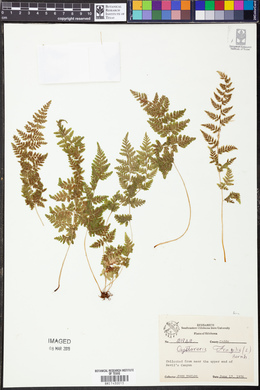|
|
|
|
Family: Woodsiaceae
brittle bladderfern, more...fragile bladder fern, brittle bladder fern
[Cystopteris dickieana Sim, moreCystopteris fragilis ssp. dickieana (Sim) Hyl., Cystopteris fragilis var. angustata Lawson, Cystopteris fragilis var. woodsioides Christ, Filix fragilis (L.) Underwood] |
Stems creeping, not cordlike, internodes short, beset with old petiole bases, hairs absent; scales tan to light brown, lanceolate, radial walls thin, luminae tan. Leaves monomorphic, clustered at stem apex, to 40 cm, nearly all bearing sori. Petiole dark at base, mostly green to straw-colored distally, shorter than or nearly equaling blade, base sparsely scaly. Blade lanceolate to narrowly elliptic, 1(--2)-pinnate-pinnatifid, widest at or just below middle, apex acute; rachis and costae lacking gland-tipped hairs or bulblets; axils of pinnae lacking multicellular, gland-tipped hairs. Pinnae usually perpendicular to rachis, not curving toward blade apex, margins serrate to sharply dentate; proximal pinnae pinnatifid to pinnate-pinnatifid, ± equilateral, basiscopic pinnules not enlarged; basal basiscopic pinnules sessile, base truncate to obtuse, distal pinnae deltate to ovate. Veins directed mostly into teeth. Indusia ovate to lanceolate, without gland-tipped hairs. Spores spiny or verrucate, usually 39--60 µm. 2 n = 168, 252. Sporulating summer--fall. Mostly on cliff faces, also in thin soil over rock; 0--4500 m; Greenland; St. Pierre and Miquelon; Alta., B.C., Man., N.B., Nfld., N.W.T., N.S., Ont., P.E.I., Que., Sask., Yukon; Alaska, Calif., Colo., Conn., Idaho, Ill., Ind., Iowa, Kans., Maine, Mass., Mich., Minn., Mont., Nebr., Nev., N.H., N.Mex., N.Y., N.Dak., Ohio, Oreg., Pa., S.Dak., Tex., Utah, Vt., Wash., Wis., Wyo.; worldwide. Cystopteris fragilis is most often confused with C . tenuis in the east and C . reevesiana in the southwest. Habitat and geography, as well as the morphologic features discussed in the key, usually serve to separate these taxa. For instance, C . fragilis is more likely to be found on cliffs whereas the other species prefer boulders and soil ( C . fragilis occurs at higher elevations and/or latitudes than the other species). These distinctions can be confounded when C . fragilis forms hybrids with sympatric species. Sterile pentaploid plants have been discovered where C . fragilis overlaps with C . laurentiana , tetraploid hybrids are likely where C . fragilis occurs with C . tenuis , and triploids may form where C . fragilis is found with C . reevesiana . Even after segregating relatively distinct elements such as Cystopteris protrusa , C . reevesiana , and C . tenuis , and identifying sterile hybrids, C . fragilis still remains a polymorphic and complex taxon that probably contains a number of natural, cryptic evolutionary units. For example, morphologically distinct hexaploid cytotypes have been reported (C. H. Haufler and M. D. Windham 1991). These occur as isolated and disjunct populations in Ontario, Alaska, Arizona, Colorado, Montana, and Wyoming. Isozymic profiles of each of these populations indicate that the hexaploids are polyphyletic and should not be accorded species status. The presence of verrucate spores (as opposed to the normal spiny spores) has been used to circumscribe Cystopteris dickieana . Although genetic analyses have not been undertaken, we think the verrucate spore is probably a recessive feature controlled by one or a few genes. While present at low frequency in much of the range of C . fragilis , verrucate spores are particularly prominent in the Great Plains. Perhaps in this region the genetic combinations specifying verrucate spores have been fixed. Following R. F. Blasdell (1963), C . dickieana is also considered here to be conspecific with C . fragilis because (1) early stages in the development of spiny spores can appear verrucate (A. C. Jermy and L. Harper 1971), (2) the hexaploid cytotypes discussed above always have verrucate spores, regardless of their parentage, (3) individuals with verrucate spores can be found in populations that are otherwise uniformly spiny-spored, and (4) individuals and populations that have verrucate spores are not otherwise (morphologically, ecologically, or genetically) distinct from those that have spiny spores. Especially in the western portion of its North American range (British Columbia, Washington, Montana, Idaho, Oregon, California), Cystopteris fragilis appears to be developing morphologically and ecologically distinctive variants. Hybrid individuals with aborted spores have been discovered, and plants from these areas increasingly tend to grow on both soil and rock and to have slightly different morphologies on the two substrates. These variants intergrade, however, and are not sufficiently distinct to warrant species status. This polymorphic polyploid is probably actively speciating at the tetraploid level, perhaps through gene silencing (C. R. Werth and M. D. Windham 1991).
General: Stems creeping, not cordlike, numerous old petiole bases present, with tan to light brown scales. Leaves: Several variable erect fronds, clustered, reaching 40 cm, all bearing sori, petiole dark at base, mostly green to straw-colored toward the tip, sparsely scaly at base; blade lanceolate to narrowly elliptic, 1-2 pinnate, widest at or below middle, apex acute, rachis and costae lack gland tip hairs or bulblets, axils of pinnae lack gland-tipped hairs; pinnae perpendicular to rachis, not curving toward apex, margins serrate to sharply dentate; lower pinnae pinnatifid, more or less equilateral, base truncate to obtuse, pinnae toward tip deltate to ovate; veins directed mostly into teeth. Sporangia: Indusia ovate to lanceolate, without gland-tipped hairs, spores spiny or warty. Ecology: Found on cliff faces, often along ledges, in woods and, on rocky slopes, often in shallow soils 5,000-12,000 ft (1524-3658 m); sporulates in summer and fall. Notes: Can be easily confused with C. reevesiana, but this species is one of the most widely distributed of ferns and is part of a much larger complex that encompasses considerable variation. Distinguish this species by its being most likely found on cliffs with the pinnae perpendicular to the rachis, rather than curling toward the blade apex; the margins of the pinnae also have sharp teeth. Etymology: Cystopterisis from the Greek cystis for bladder and pteris fern, referring to the indusium, while fragilis means brittle or fragile. Sources: FNA 1993, Dittmer 1954, Yarborough and Powell 2002, Kearney and Peebles 1969 |






































































































